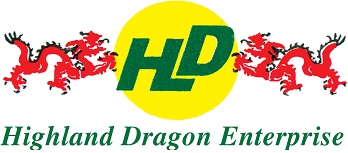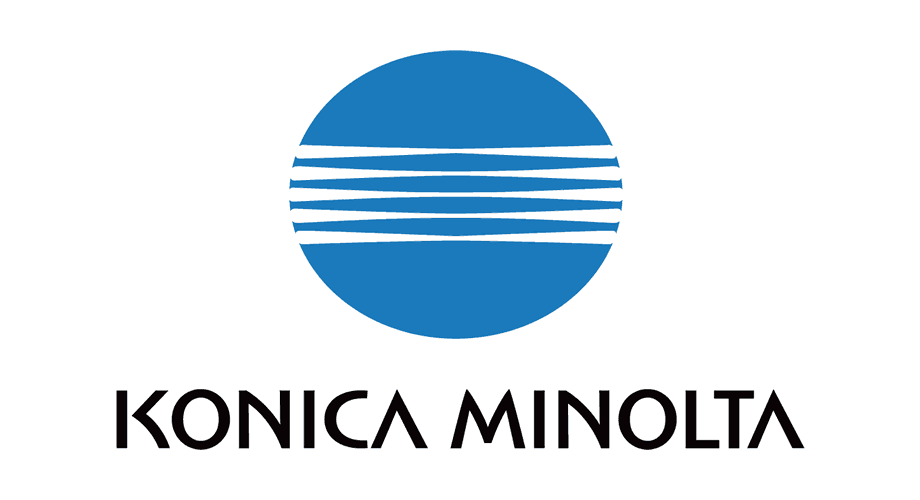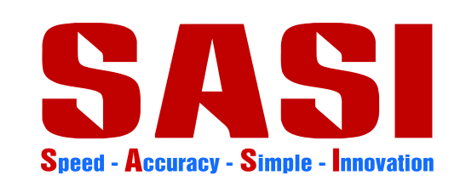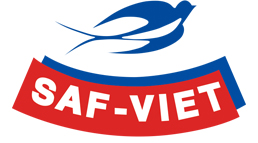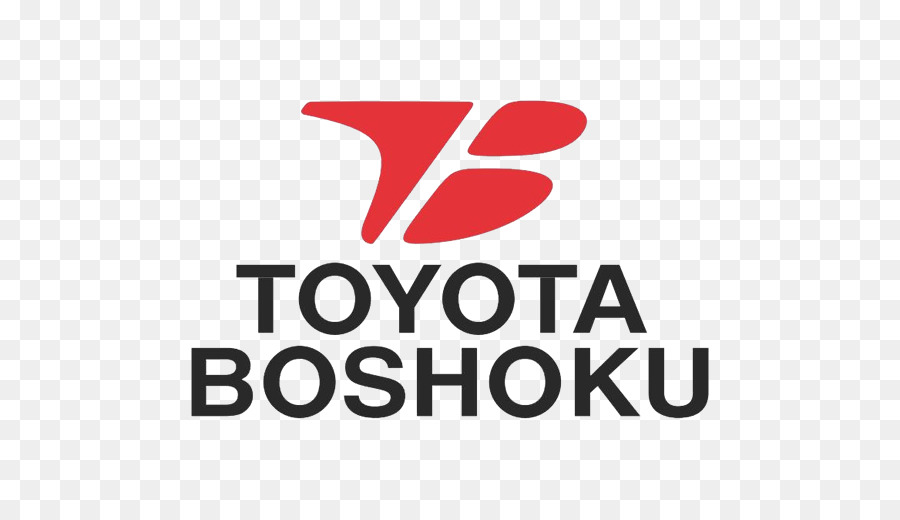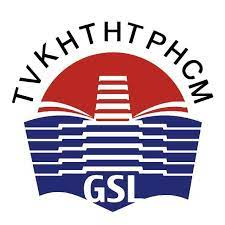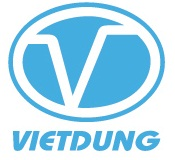Cisco Meraki MS120-8 Switch
Cisco Meraki MS120-48FP Switch
Cisco Meraki MS125-48FP Switch
Cisco Meraki MS125-24 Switch
Cisco Meraki MS120-48LP Switch
Cisco Meraki MS125-48 Switch
Cisco Meraki MS120-8LP Switch
Cisco Meraki MS125-24P Switch
Cisco Meraki MS125-48LP Switch

Thiết bị chuyển mạch Cisco Catalyst 3650-24TS-E Switch
P/N: WS-C3650-24TS-ECisco Catalyst 3650 24 Port Data 4x1G Uplink IP Services
Liên hệ ngay
The Cisco® Catalyst® 3650 Series is the next generation of enterprise-class standalone and stackable access-layer switches that provide the foundation for full convergence between wired and wireless on a single platform. The 3650 Series is built on the advanced Cisco StackWise®-160, and takes advantage of the new Cisco Unified Access™ Data Plane (UADP) application-specific integrated circuit (ASIC). This switch can enable uniform wired-wireless policy enforcement, application visibility, flexibility, application optimization, and superior resiliency. The 3650 Series switches support full IEEE 802.3at Power over Ethernet Plus (PoE+), Cisco Universal Power over Ethernet (Cisco UPOE®) on the Cisco Catalyst 3650 Series multigigabit switches, and offer modular and field-replaceable redundant fans and power supplies. The 3650 Series switches also come in a 12-inch lower depth form factor so that you can deploy them in tight wiring closets in remote branches and offices where depth of the switch is a concern. In addition, the 3650 multigigabit switches support current and next-generation wireless speeds and standards (including 802.11ac Wave 2) on existing cabling infrastructure. The 3650 Series switches help increase wireless productivity and reduce TCO.
Product Overview
- Integrated wireless controller capability with:
- Up to 40G of wireless capacity per switch (48-port models)
- Support for up to 50 access points and 1000 wireless clients on each switching entity (switch or stack)
- 24 and 48 10/100/1000 data and PoE+ models with energy-efficient Ethernet (EEE) supported ports
- 24 and 48 100-Mbps and 1-, 2.5-, 5-, and 10-Gbps (multigigabit) Cisco UPOE and PoE+ models with EEE
- Five fixed-uplink models with four Gigabit Ethernet, two 10 Gigabit Ethernet, four 10 Gigabit Ethernet, eight 10 Gigabit Ethernet, or two 40 Gigabit Ethernet Quad Small Form-Factor Pluggable Plus (QSFP+) ports
- 24-port and 48-port 10/100/1000 PoE+ models with lower noise and reduced depth of 11.62 inches for shallow depth cabinets in enterprise, retail, and branch-office environments
- Optional Cisco StackWise-160 technology that provides scalability and resiliency with 160 Gbps of stack throughput
- Dual redundant, modular power supplies and three modular fans providing redundanc
- Support for external power system RPS 2300 on the 3650 mini SKUs for power redundancy
- Full IEEE 802.3at (PoE+) with 30W power on all ports in 1 rack unit (RU) form factor
- Cisco UPOE with 60W power per port in 1 rack unit (RU) form factor
- IEEE 802.3bz (2.5GBASE-T and 5GBASE-T) to go beyond 1 Gbps with existing Category 5e and Category 6
- IEEE 802.1ba Audio Video Bridging (AVB) built in to provide a better AV experience, including improved time synchronization and quality of service (QoS)
- Software support for IPv4 and IPv6 routing, multicast routing, modular QoS, Flexible NetFlow (FNF) Version 9, and enhanced security features
- Single universal Cisco IOS® Software image across all license levels, providing an easy upgrade path for software features
- Enhanced limited lifetime warranty (E-LLW) with next business day (NBD) advance hardware replacement and 90-day access to Cisco Technical Assistance Center (TAC) support
Switch Models and Configurations
All Cisco Catalyst 3650 Series Switches have fixed, built-in uplink ports and ship with one power supply. Tables 1 through 5 provide further details.
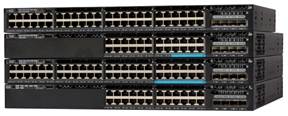
|
Models |
Fixed Uplinks |
Total 10/100/1000 Ethernet Ports |
Default AC Power Supply |
Available PoE Power |
|
WS-C3650-24TS |
4 x Gigabit Ethernet with Small Form‑Factor Pluggable (SFP) |
24 |
250 WAC |
- |
|
WS-C3650-48TS |
48 |
|||
|
WS-C3650-24PS |
24 PoE+ |
640 WAC |
390 W |
|
|
WS-C3650-48PS |
48 PoE+ |
|||
|
WS-C3650-48FS |
48 PoE+ |
1025 WAC |
775 W |
|
|
WS-C3650-24TD |
2 x 10 Gigabit Ethernet with SFP+ and 2 x 1 Gigabit Ethernet with SFP |
24 |
250 WAC |
|
|
WS-C3650-48TD |
48 |
|
|
|
|
WS-C3650-24PD |
24 PoE+ |
640 WAC |
390 W |
|
|
WS-C3650-24PDM |
24 PoE+ |
Fixed 640 WAC |
390 W |
|
|
WS-C3650-48PD |
48 PoE+ |
640 WAC |
390 W |
|
|
WS-C3650-48FD |
48 PoE+ |
1025 WAC |
775 W |
|
|
WS-C3650-8X24PD |
|
24 PoE+ (with 8 100-Mbps and 1-, 2.5-, 5-, and 10-Gbps ports) |
715 WAC |
435 W |
|
WS-C3650-12X48FD |
|
48 PoE+ (with 12 100-Mbps and 1-, 2.5-, 5-, and 10-Gbps ports) |
1100 WAC |
660 W |
|
WS-C3650-48TQ |
4 x 10 Gigabit Ethernet with SFP+ or 4 x Gigabit Ethernet with SFP |
48 |
250 WAC |
|
|
WS-C3650-48PQ |
48 PoE+ |
640 WAC |
390 W |
|
|
WS-C3650-48FQ |
48 PoE+ |
1025 WAC |
775 W |
|
|
WS-C3650-48FQM |
48 PoE+ |
Fixed 975 WAC |
775 W |
|
|
WS-C3650-8X24UQ |
24 UPOE (with 8 100-Mbps and 1‑, 2.5-, 5-, and 10-Gbps ports) |
1100 WAC |
820 W |
|
|
WS-C3650-12X48UQ |
48 UPOE (with 12 100-Mbps and 1‑, 2.5-, 5-, and 10-Gbps ports) |
1100 WAC |
660 W |
|
|
WS-C3650-12X48UR |
8 x 10 Gigabit Ethernet with SFP+ or 8 x Gigabit Ethernet with SFP |
48 UPOE (with 12 100-Mbps and 1-, 2.5-, 5-, and 10-Gbps ports) |
1100 WAC |
660 W |
|
WS-C3650-12X48UZ |
2 x 40 Gigabit Ethernet with QSFP+ |
48 UPOE (with 12 100-Mbps and 1-, 2.5-, 5-, and 10-Gbps ports) |
1100 WAC |
660 W |
Fixed Uplinks
All Cisco Catalyst 3650 Series Switches have fixed, built-in uplink ports. Customers can choose from five types of uplink ports at the time of the switch purchase:
- Four Gigabit Ethernet with Small Form-Factor Pluggable (SFP)
- Two 10 Gigabit Ethernet with SFP+ and two 10 Gigabit Ethernet with SFP or four Gigabit Ethernet with SFP
- Four 10 Gigabit Ethernet with SFP+ or four Gigabit Ethernet with SFP
- Eight 10 Gigabit Ethernet with SFP+ or eight Gigabit Ethernet with SFP
- Two 40 Gigabit Ethernet with QSFP+
The SFP+ interface supports both 10 Gigabit Ethernet and Gigabit Ethernet ports. Refer to Table 1 for a description of the basic switch models and the corresponding uplink ports.
1 and 10 Gigabit Fixed Uplink Configurations
|
|
Interface Options |
|
|
Fixed Uplink Ports |
10 Gigabit Ethernet SFP+ Ports |
Gigabit Ethernet SFP Ports |
|
4 x Gigabit Ethernet fixed uplink ports |
0 |
4 |
|
4 x Gigabit Ethernet or 2 x 10 and 2 x 1 Gigabit Ethernet fixed uplink ports |
2 |
0 |
|
0 |
4 |
|
|
2 |
2 |
|
|
4 x Gigabit Ethernet and 4 x 10 Gigabit Ethernet fixed uplink ports |
4 |
0 |
|
0 |
4 |
|
|
2 |
2 |
|
|
3 |
1 |
|
|
1 |
3 |
|
|
8 x Gigabit Ethernet or 8 x 10 Gigabit Ethernet fixed uplink ports |
8 |
0 |
|
0 |
8 |
|
|
Any combination of 10 Gigabit Ethernet and remaining 1 Gigabit Ethernet uplink ports |
||
Dual Redundant Modular Power Supplies and External RPS2300
The Cisco Catalyst 3650 Series Switches support dual redundant power supplies (see Figure 2). The switch ships with one power supply by default, and the second power supply can be purchased at the time of ordering the switch or at a later time. If only one power supply is installed, it should always be in power supply bay 1. The switch also ships with three field-replaceable fans.

Switch Models and Corresponding Default Power Supplies
|
Models |
Default Power Supply |
Available PoE Power |
Support Secondary Power Supply |
|
24-port data switch |
PWR-C2-250WAC |
- |
Yes |
|
48-port data switch |
Yes |
||
|
24-port PoE switch |
PWR-C2-640WAC |
390 W |
Yes |
|
48-port PoE switch |
Yes |
||
|
48-port full PoE switch |
PWR-C2-1025WAC |
775 W |
Yes |
|
24-port mini PoE switch |
Fixed 640 WAC |
390W |
No, but supports RPS 2300 |
|
48-port mini PoE switch |
Fixed 975 WAC |
775W |
No, but supports RPS 2300 |
|
24-port Multigigabit PoE switch |
PWR-C1-715WAC |
435 W |
Yes |
|
24-port Multigigabit UPOE switch |
PWR-C1-1100WAC |
820 W |
Yes |
|
48-port Multigigabit full PoE switch |
|
|
|
|
48-port Multigigabit UPOE switch |
660 W |
Yes |
The multigigabit switches support a different set of power supplies than the non-multigigabit switches. In addition the PWR-C1-350WAC is not supported on the multigigabit switches. In addition to the power supplies listed in Table 3, a 640W DC power supply is available at the time of order or as a spare on all non-multigigabit switch models. The DC power supply also delivers PoE capabilities for maximum flexibility (refer to Table 4 for available PoE budget with DC power supplies). Customers can mix and match the AC and DC power supplies in the two available power supply slots. Any of these power supplies can be installed in any of the switches.
vailable PoE with DC Power Supply
|
Model |
Number of DC Power Supplies |
Total Available PoE Budget |
|
24-port or 48-port PoE Switch (non-multigigabit) |
1 |
390 W |
|
2 |
780 W |
|
|
24-port PoE Switch (Multigigabit) |
1 |
160 W |
|
2 |
600 W |
|
|
48-port PoE Switch (Multigigabit) |
1 |
0 W |
|
2 |
440 W |
Power over Ethernet Plus (PoE+)
The Cisco Catalyst 3650 Series Switches support both PoE (IEEE 802.3af) and PoE+ (IEEE 802.3at standard), which provide up to 30 W of power per port. PoE removes the need for wall power to each PoE-enabled device and eliminates the cost for additional electrical cabling and circuits that would otherwise be necessary in IP phone and WLAN deployments. The 3650 Series can provide a lower TCO for deployments that incorporate Cisco IP phones, Cisco Aironet® wireless LAN (WLAN) access points, or any IEEE 802.3at-compliant end device. Table 5 shows the power supply combinations required for different PoE needs.
Minimum Power Supply Requirements for Full PoE and PoE+
|
|
24-Port PoE Switch |
48-Port PoE Switch |
|
PoE on All Ports |
One PWR-C2-640 WAC |
One PWR-C2-1025WAC or Two PWR-C2-640 WAC |
|
PoE+ on All Ports |
One PWR-C2-1025WAC or Two PWR-C2-640 WAC |
Two PWR-C2-1025 WAC |
Cisco Universal Power over Ethernet (Cisco UPOE)
Cisco UPOE is a breakthrough technology, offering the following services and benefits:
- 60W per port to enable a variety of end devices such as Samsung VDI client, BT IP turret systems in trading floors, Cisco Catalyst compact switches in retail and hospitality environments, personal Cisco TelePresence® systems, and physical access control devices
- High availability for power and guaranteed uninterrupted services, a requirement for critical
applications (e911) - Lower OpEx by providing network resiliency at lower cost by consolidating backup power into
the wiring closet - Faster deployment of new campus access networking infrastructures by eliminating the need for a power outlet for every endpoint
The Cisco UPOE capability is available only on select multigigabit models.
ower Supply Requirements for Cisco UPOE
|
|
24-Port Multigigabit Cisco UPOE Switch |
48-Port Multigigabit Cisco UPOE Switch |
|
Cisco UPOE (60W per port) on all |
One 1100W and one 715W power supplies or two 1100W power supplies |
Two 1100W power supplies |
Cisco Catalyst Multigigabit Technology
Cisco Multigigabit Ethernet is a unique innovation to the new Cisco Catalyst Ethernet access switches. With the enormous growth of 802.11ac and new wireless applications, wireless devices are promoting the demand for more network bandwidth. This creates a need for a technology that supports speeds higher than 1 Gbps on all cabling infrastructure. Cisco multigigabit technology allows you to achieve bandwidth speeds from 1 Gbps through 10 Gbps over traditional Category 5e (Cat 5e) cabling or above. In addition, the multigigabit ports on select Cisco Catalyst switches support Cisco UPOE, which is increasingly important for next-generation workspaces and Internet of Things (IoT) ecosystems.
Cisco multigigabit technology offers significant benefits for a diverse range of speeds, cable types, and PoE power. The benefits can be grouped into three different areas:
- Multiple speeds: Cisco Catalyst Multigigabit Technology supports autonegotiation of multiple speeds on switch ports. The supported speeds are 100 Mbps, 1 Gbps, 2.5 Gbps, and 5 Gbps on Cat 5e cable and up to 10 Gbps over Cat 6a cabling
- Cable type: The technology supports a wide range of cable types, including Cat 5e, Cat 6, and Cat 6a or above
- PoE power: The technology supports PoE, PoE+, and Cisco UPOE for all the supported speeds and cable types
Cisco Catalyst 3650 Mini Switches
The Cisco Catalyst 3650 Series adds new mini switches to the existing 3650 family of switches. These switches are less than 12” deep and quieter than the existing 3650 switches, making them perfect to deploy in tight wiring cabinets, racks, or user spaces where depth of the switch is a concern. You can avoid replacing the cabinets or mounting the switch at an angle and as a result reduce downtime to the network. These switches enable the same uniform wired-wireless policy enforcement, application visibility, flexibility, application optimization, and superior resiliency as the existing 3650 switches. They come in 24- and 48-port 10M/100M/1000M switch SKUs (WS-C3650-24PDM and WS-C3650-48FQM) and support all the same features as the existing 3650 switches except that they come with fixed fans, fixed power supplies, and support for external RPS2300 for redundancy. These PoE switches support both PoE (IEEE 802.3af) and PoE+ (IEEE 802.3at standard), providing up to 30W of power for 12 ports for a total of 390W on the 24-port model and up to 30W of power for 24 ports for a total of 775W on the 48-port model. The 24-port switch has 2x1 Gigabit Ethernet SFP and 2x10 Gigabit Ethernet SFP+ uplinks; the 48-port switch has 4x10 Gigabit Ethernet SFP+ uplinks to support any high-bandwidth application. These switches support stacking and can stack with each other or the existing 3650 switches using the same Cisco StackWise-160 technology. The 3650 mini and 3650 use the same software and thus can be deployed and managed using the same policies, configuration, and so on as the existing 3650 switches. Some use cases for the 3650 mini are the following:
Small Offices and Branches
Many small branches and satellite offices where there are few employees do not have larger wiring closets because of space constraints. A typical office like this has smaller cabinets and would need a switch that can serve few employees, provide PoE support, can manage wired-wireless networks, and applies the same consistent policies as a bigger branch or office. Because of its less than 12” depth, lower noise, and support for 10G uplinks along with stacking, advanced security, and wired-wireless convergence, the 3650 mini is the perfect switch for this type of space.
Education
The 3650 mini switch extends access to labs, classrooms, and other training rooms from the central/floor distribution rooms, reducing cost of cabling and providing superior quality of service with enhanced security, wired-wireless convergence, and enterprise network features. Because of its shallow depth and lower noise, these switches are ideally suited for classrooms or confined areas.
Retail
A typical retail outlet needs to serve customers at multiple sales points, each with a POS machine, access points, phone, printer, video display with network, and some PoE powering. These retail outlets connect to the access router that connects them to the outside network and typically need switches that fit in shallow depth cabinets. Because of the 12” depth of these switches along with advanced security and networking features, they can help retailers efficiently utilize space and save on real estate cost.
Benefits
Converged Wired plus Wireless Access
The Cisco Catalyst 3650 Series is a standalone and stackable access switching platform that enables wired plus wireless services on a single Cisco IOS XE Software-based platform. With this, Cisco has pioneered a host of rich capabilities such as high availability based on stateful switchover (SSO) on stacking, granular QoS, security, and Flexible NetFlow (FNF) across wired and wireless in a seamless fashion. Also, the wired plus wireless features are bundled into a single Cisco IOS Software image, which reduces the number of software images that users have to qualify/certify before enabling them in their network. The single console port for command-line interface (CLI) management reduces the number of touch points to manage for wired plus wireless services, thereby reducing network complexity, simplifying network operations, and lowering the TCO to manage the infrastructure.
Converged wired plus wireless not only improves wireless bandwidth across the network but also the scale of wireless deployment. Each 48-port Cisco Catalyst 3650 provides 40 Gbps of wireless throughput (20 Gbps on the 24-port model). This wireless capacity increases with the number of members in the stack. This makes sure that the network can scale with current wireless bandwidth requirements, as dictated by IEEE 802.11n-based access points and with future wireless standards such as IEEE 802.11ac. Additionally, the Cisco Catalyst 3650 distributes the wireless controller functions to achieve better scalability. Each Cisco Catalyst 3650 switch/stack can operate as the wireless controller in two modes:
- Mobility agent (MA): This is the default mode in which the Cisco Catalyst 3650 switch ships. In this mode the switch is capable of terminating the CAPWAP tunnels from the access points and providing wireless connectivity to wireless clients. Maintaining wireless client databases and configuring and enforcing security and QoS policies for wireless clients and access points can be enforced in this mode. No additional license on top of IP Base is required to operate in the mobility agent mode.
- Mobility controller (MC): In this mode, the Cisco Catalyst 3650 switch can perform all the mobility agent tasks in addition to mobility coordination, radio resource management (RRM), and Cisco CleanAir® coordination within a mobility subdomain. The mobility controller mode can be enabled on the switch CLI. IP Base license level is required when the Cisco Catalyst 3650 switch is acting as the mobility controller. A centrally located Cisco 5508 Wireless LAN Controller (WLC 5508), Cisco Wireless Services Module 2 (WiSM2) (when running AireOS Version 7.3), and Wireless LAN Controller 5760 can also perform this role for larger deployments.
With mobility agents located in the wiring closets providing 40 Gbps of wireless per switch (n x 40 Gbps for a stack of n switches) and mobility controllers managing some of the central wireless functions, the converged access-based wireless deployment provides best-in-class scalability for wireless and significantly improved wireless throughput.
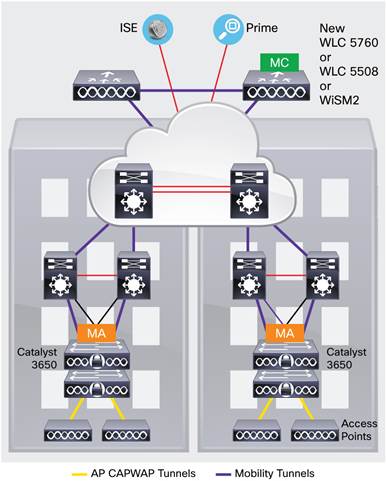
Distributed Intelligent Services
Flexible NetFlow (FNF)
Full visibility into the wired plus wireless traffic is achieved because of the access point Control and Provisioning of Wireless Access Points (CAPWAP) tunnel termination on the switch. This helps identify users and user traffic flows in order to identify potential attackers and take corrective action at the access layer before the attack penetrates further into the network. This is achieved using FNF, which monitors every single flow entering and exiting the switch stack for wired and wireless users. It also helps identify the top wired/wireless talkers and enforce appropriate bandwidth provisioning policies.
QoS
The 3650 switch has advanced wired plus wireless QoS capabilities. It uses the Cisco modular QoS command line interface (MQC). The switch manages wireless bandwidth using unprecedented hierarchical bandwidth management starting at the per-access-point level and drilling further down to per-radio, per-service set identification (SSID), and per-user levels. This helps manage and prioritize available bandwidth between various radios and various SSIDs (enterprise, guest, and so on) within each radio on a percentage basis. The switch is also capable of automatically allocating equal bandwidth among the connected users within a given SSID. This makes sure that all users within a given SSID get a fair share of the available bandwidth while being connected to the network. The UADP ASIC enables the hierarchical bandwidth management and fair sharing of bandwidth, thereby providing hardware-based QoS for optimized performance at line-rate traffic.
In addition to these capabilities, the switch is able to do class of service (CoS) or differentiated services code point (DSCP) based queuing, policing, shaping, and marking of wired plus wireless traffic. This enables users to create common policies that can be used across wired plus wireless traffic. The 3650 also supports downloadable policy names from the Cisco Identity Services Engine (ISE) when a user successfully authenticates to the network using the ISE.
Security
The Cisco Catalyst 3650 provides a rich set of security features for wired plus wireless users. Features such as IEEE 802.1x, Dynamic Host Configuration Protocol (DHCP) snooping, IP Source Guard and control plane protection, wireless intrusion prevention systems (WIPSs), and so on enable protection against unauthorized users and attackers. With a variety of wired plus wireless users connecting to the network, the switch supports session-aware networking, in which each device connected to the network is identified as one session, and unique access control lists (ACLs) and/or QoS policies can be defined and applied using the ISE for each of these sessions, providing better control on the devices connecting to the network.
Resiliency
Cisco StackWise-160 Technology
The Cisco Catalyst 3650 supports an optional stacking module that is based on the Cisco StackWise-160 technology. Cisco StackWise-160 technology is built on the highly successful industry-leading StackWise technology, which is a premium stacking architecture. StackWise-160 has a stack bandwidth of 160 Gbps. StackWise‑160 uses Cisco IOS Software SSO for providing resiliency within the stack. The stack behaves as a single switching unit that is managed by an “active” switch elected by the member switches. The active switch automatically elects a standby switch within the stack. The active switch creates and updates all the switching/routing/wireless information and constantly synchronizes that information with the standby switch. If the active switch fails, the standby switch assumes the role of the active switch and continues to the keep the stack operational. Access points continue to remain connected during an active-to-standby switchover. A working stack can accept new members or delete old ones without service interruption. StackWise-160 creates a highly resilient single unified system of up to nine switches, providing simplified management using a single IP address, single Telnet session, single CLI, auto-version checking, auto-upgrading, auto-configuration, and more. StackWise-160 also enables local switching in Cisco Catalyst 3650 Series Switches.
Foundation for Open Network Environment
The heart of the Cisco Catalyst 3650 is the UADP ASIC with programmability for future features and intelligence with investment protection. The new ASIC provides the foundation for converged APIs across wired and wireless, Cisco Open Network Environment, software-defined networking (SDN) readiness and OnePK SDK through software updates over the product lifetime.
Software Features and Services on Cisco Catalyst 3650 Series Switches
Software services supported on the Cisco Catalyst 3650 Series Switches can be classified into five broad categories:
- Ease of operations
- Advanced security features
- Resiliency
- Application visibility and control
- Audio Video Bridging (AVB)
Ease of Operations
The Cisco Catalyst 3650 helps reduce the operating costs through:
- Cisco Catalyst Smart Operations
- Easy-to-use deployment and control features
- Efficient switch operations
- Network management tools
Cisco Catalyst Smart Operations
Cisco Catalyst Smart Operations are a comprehensive set of capabilities that simplify LAN deployment, configuration, and troubleshooting. In addition to adaptive, always-on technologies such as StackWise-160, Cisco Catalyst Smart Operations enable zero-touch installation and replacement of switches, fast upgrade, and ease of troubleshooting with reduced operational cost. Cisco Catalyst Smart Operations are a set of features that includes Smart Install, Auto Smartports, Smart Configuration and Smart Troubleshooting to enhance operational excellence:
- Cisco Smart Install is a transparent plug-and-play technology to configure the Cisco IOS Software image and switch configuration without user intervention. Smart Install utilizes dynamic IP address allocation and the assistance of other switches to facilitate installation, providing transparent network plug and play.
- Cisco Auto Smartports provide automatic configuration as devices connect to the switch port, allowing auto‑detection and plug and play of the device onto the network.
- Cisco Smart Troubleshooting is an extensive array of debug diagnostic commands and system health checks within the switch, including Generic Online Diagnostics (GOLD) and Onboard Failure Logging (OBFL).
- Embedded Event Manager (EEM) is a powerful and flexible feature that provides real-time network event detection and onboard automation. Using EEM, customers can adapt the behavior of their network devices to align with their business needs. This feature requires the IP Base feature set.
Easy-to-Use Deployment and Control Features
- User experience:
- IP service-level agreements (SLAs) enable customers to assure new business-critical IP applications, as well as IP services that utilize data, voice, and video, in an IP network. This feature requires the IP Services feature set.
- DHCP autoconfiguration of multiple switches through a boot server eases switch deployment.
- Automatic QoS (AutoQoS) simplifies QoS configuration in voice over IP (VoIP) networks by issuing interface and global switch commands to detect Cisco IP phones, classify traffic, and help enable egress queue configuration.
- Autonegotiation on all ports automatically selects half- or full-duplex transmission mode to optimize bandwidth.
- Automatic media-dependent interface crossover (MDIX) automatically adjusts transmit and receive pairs if an incorrect cable type (crossover or straight through) is installed.
- Simplified configuration and connectivity:
- Dynamic Trunking Protocol (DTP) facilitates dynamic trunk configuration across all switch ports.
- Port Aggregation Protocol (PAgP) automates the creation of Cisco Fast EtherChannel groups or Gigabit EtherChannel groups to link to another switch, router, or server.
- Link Aggregation Control Protocol (LACP) allows the creation of Ethernet channeling with devices that conform to IEEE 802.3ad. This feature is similar to Cisco EtherChannel technology and PAgP.
- Unidirectional Link Detection Protocol (UDLD) and aggressive UDLD allow unidirectional links caused by incorrect fiber-optic wiring or port faults to be detected and disabled on fiber-optic interfaces.
- Cisco VLAN Trunking Protocol (VTP) Version 3 supports dynamic VLANs and dynamic trunk configuration across all switches.
- Efficient switch operation:
- Switching database manager (SDM) templates, VLAN template (specific to LAN Base license level), and advanced template allow the administrator to automatically optimize the ternary content-addressable memory (TCAM) allocation to the desired features based on deployment-specific requirements.
- Local proxy Address Resolution Protocol (ARP) works in conjunction with private VLAN edge to minimize broadcasts and maximize available bandwidth.
- Stacking master configuration management with Cisco StackWise-160 technology helps make sure that all switches are automatically upgraded when the master switch receives a new software version. Automatic software version checking and updating help ensure that all stack members have the same software version.
- Trivial File Transfer Protocol (TFTP) reduces the cost of administering software upgrades by downloading from a centralized location.
- Network Timing Protocol (NTP) provides an accurate and consistent timestamp to all intranet switches.
- Multicast:
- Optimized multicast for wired plus wireless: Cisco Catalyst 3650 offers greater multicast efficiency by receiving only one multicast stream and replicating it for all connected wired plus wireless devices connected to that switch.
- Internet Group Management Protocol (IGMP) v1, v2, v3 snooping for IPv4: multicast listener discovery (MLD) v1 and v2 snooping provides fast client joins and leaves of multicast streams and limits bandwidth-intensive video traffic to only the requestors.
- Monitoring:
- Remote Switch Port Analyzer (RSPAN) allows administrators to remotely monitor ports in a Layer 2 switch network from any other switch in the same network.
- For enhanced traffic management, monitoring, and analysis, the Embedded Remote Monitoring (RMON) software agent supports four RMON groups (history, statistics, alarms, and events).
- Layer 2 traceroute eases troubleshooting by identifying the physical path that a packet takes from source to destination.
- Wireless RF management provides both real-time and historical information about RF interference affecting network performance across controllers using systemwide Cisco CleanAir technology integration.
Efficient Switch Operation
Cisco Catalyst 3650 Series Switches, designed and engineered by Cisco, provide optimum power-saving, EEE, low-power operations for industry best-in-class power management and power consumption capabilities. The Cisco Catalyst 3650 ports are capable of reduced power modes so that ports not in use can move into a lower power utilization state. Other efficient switch operation features are:
- Cisco Discovery Protocol Version 2 allows the Cisco Catalyst 3650 Series Switches to negotiate a more granular power setting when connecting to a Cisco powered device such as IP phones or access points than what is provided by IEEE classification.
- Per-port power consumption command allows customers to specify a maximum power setting on an individual port. Per-port PoE power sensing measures actual power being drawn, enabling more intelligent control of powered devices.
- The PoE MIB provides proactive visibility into power usage and allows customers to set different power-level thresholds.
Environmentally Responsible
Organizations may choose to turn off access point radios to reduce power consumption during off-peak hours. The integrated wireless LAN controller avoids the deployment of additional devices in the network.
Network Management Tools
The Cisco Catalyst 3650 Series Switches offer both a superior CLI for detailed configuration and Cisco Prime™ infrastructure for unified wired plus wireless management. Cisco Prime infrastructure provides day 0 and ongoing provisioning, ongoing monitoring and maintenance, configuration templates, and device and user 360-degree views and serves as the FNF collector for user traffic views using the Cisco Prime Assurance Manager module.
Advanced Security Features
Cisco Catalyst 3650 Series Switches support advanced security features including but not limited to:
- Protection against attackers:
- Port security secures the access to an access or trunk port based on MAC address. It limits the number of learned MAC addresses to deny MAC address flooding.
- DHCP snooping prevents malicious users from spoofing a DHCP server and sending out bogus addresses. This feature is used by other primary security features to prevent a number of other attacks such as ARP poisoning.
- Dynamic ARP inspection (DAI) helps ensure user integrity by preventing malicious users from exploiting the insecure nature of ARP.
- IP source guard prevents a malicious user from spoofing or taking over another user’s IP address by creating a binding table between the client’s IP and MAC address, port, and VLAN.
- The Unicast Reverse Path Forwarding (RPF) feature helps mitigate problems caused by the introduction of malformed or forged (spoofed) IP source addresses into a network by discarding IP packets that lack a verifiable IP source address.
- Bidirectional data support on the SPAN port allows the Cisco intrusion detection system (IDS) to take action when an intruder is detected.
- User authentication:
- Flexible authentication that supports multiple authentication mechanisms, including 802.1X, MAC authentication bypass, and web authentication using a single, consistent configuration.
- RADIUS change of authorization and downloadable calls for comprehensive policy management capabilities.
- Private VLANs restrict traffic between hosts in a common segment by segregating traffic at Layer 2, turning a broadcast segment into a nonbroadcast multiaccess like segment. Private VLAN edge provides security and isolation between switch ports, which helps ensure that users cannot snoop on other users’ traffic.
- Multidomain authentication allows an IP phone and a PC to authenticate on the same switch port while placing them on appropriate voice and data VLAN.
- MAC address notification allows administrators to be notified of users added to or removed from the network.
- Mobility and security for secure, reliable wireless connectivity and consistent end-user experience. Increased network availability through proactive blocking of known threats.
- IGMP filtering provides multicast authentication by filtering out nonsubscribers and limits the number of concurrent multicast streams available per port.
- ACLs:
- Cisco security VLAN ACLs on all VLANs prevent unauthorized data flows from being bridged within VLANs.
- Cisco standard and extended IP security router ACLs define security policies on routed interfaces for control-plane and data-plane traffic. IPv6 ACLs can be applied to filter IPv6 traffic.
- Port-based ACLs for Layer 2 interfaces allow security policies to be applied on individual switch ports.
- Device access:
- Secure Shell (SSH) Protocol, Kerberos, and Simple Network Management Protocol Version 3 (SNMPv3) provide network security by encrypting administrator traffic during Telnet and SNMP sessions. SSH Protocol, Kerberos, and the cryptographic version of SNMPv3 require a special cryptographic software image because of U.S. export restrictions.
- TACACS+ and RADIUS authentication facilitates centralized control of the switch and restricts unauthorized users from altering the configuration.
- Multilevel security on console access prevents unauthorized users from altering the switch configuration.
- Bridge protocol data unit (BPDU) Guard shuts down Spanning Tree PortFast-enabled interfaces when BPDUs are received to avoid accidental topology loops.
- Spanning Tree Root Guard (STRG) prevents edge devices not in the network administrator’s control from becoming Spanning Tree Protocol root nodes.
- Wireless end-to-end security offers CAPWAP-compliant DTLS encryption to make sure of encryption between access points and controllers across remote WAN/LAN links.
Resiliency
Borderless networks enable enterprise mobility and business-grade video services. Industry’s first unified network (wired plus wireless) location services enable tracking of mobile assets and the users of those assets for both wired plus wireless devices. The true borderless experience is enabled by the following feature sets in the Cisco Catalyst 3650 Series Switches:
- High availability
- High-performance IP routing
- Superior QoS
High Availability
- In addition to StackWise-160, the Cisco Catalyst 3650 Series supports high-availability features including but not limited to the following:
- Cross-Stack EtherChannel provides the ability to configure Cisco EtherChannel technology across different members of the stack for high resiliency.
- Flexlink provides link redundancy with convergence time less than 100ms.
- IEEE 802.1s/w Rapid Spanning Tree Protocol (RSTP) and Multiple Spanning Tree Protocol (MSTP) provide rapid spanning-tree convergence independent of spanning-tree timers and also offer the benefit of Layer 2 load balancing and distributed processing. Stacked units behave as a single spanning-tree node.
- Per-VLAN Rapid Spanning Tree (PVRST+) allows rapid spanning-tree reconvergence on a per-VLAN spanning-tree basis, without requiring the implementation of spanning-tree instances.
- Switch-port autorecovery (Err-disable) automatically attempts to reactivate a link that is disabled because of a network error.
High-Performance IP Routing
The Cisco Express Forwarding hardware routing architecture delivers extremely high-performance IP routing in the Cisco Catalyst 3650 Series Switches:
- IP unicast routing protocols (static, Routing Information Protocol Version 1 [RIPv1], and RIPv2, RIPng, Enhanced Interior Gateway Routing Protocol [EIGRP] stub) are supported for small-network routing applications with the IP Base feature set. Limited static routing with the LAN Base feature set. Equal-cost routing facilitates Layer 3 load balancing and redundancy across the stack.
- Advanced IP unicast routing protocols (Open Shortest Path First [OSPF], EIGRP, Border Gateway Protocol Version 4 [BGPv4], and Intermediate System-to-Intermediate System Version 4 [IS-ISv4]) are supported for load balancing and constructing scalable LANs. IPv6 routing (OSPFv3, EIGRPv6) is supported in hardware for maximum performance. OSPF for routed access is included in the IP Base image. The IP Services feature set is required for full OSPF, EIGRP, BGPv4, and IS-ISv4.
- Policy-based routing (PBR) allows superior control by facilitating flow redirection regardless of the routing protocol configured. Virtual routing and forwarding (VRF)-Lite enables a service provider to support two or more VPNs, with overlapping IP addresses. The IP Base feature set is required.
- Protocol-independent multicast (PIM) for IP multicast routing is supported, including PIM sparse mode (PIM‑SM), PIM dense mode (PIM-DM), PIM sparse-dense mode, and source-specific multicast (SSM). The IP Services feature set is required.
- IPv6 addressing is supported on interfaces with appropriate show commands for monitoring and troubleshooting.
Superior QoS
The Cisco Catalyst 3650 Series offers Gigabit Ethernet speed with intelligent services that keep traffic flowing smoothly, even at 10 times the normal network speed. Industry-leading mechanisms for cross-stack marking, classification, and scheduling deliver superior performance for data, voice, and video traffic, all at wire speed.
The following are some of the QoS features supported in the Cisco Catalyst 3650 Series Switches:
- Granular wireless bandwidth management and fair sharing use Cisco’s proven Cisco IOS Software and UADP ASIC technology to provide hierarchical bandwidth management at line rate (per access point, per radio, per SSID, per client-based policies). Fair sharing across the users within an SSID makes sure that no single user is starved because of other heavy-hitting users. Fair sharing is automatically enabled for wireless at user level as well as SSID level.
- 802.1p CoS and DSCP field classification is provided, using marking and reclassification on a per-packet basis by source and destination IP address, MAC address, or Layer 4 Transmission Control Protocol/User Datagram Protocol (TCP/UDP) port number.
- Shaped round robin (SRR) scheduling helps ensure differential prioritization of packet flows by intelligently servicing the ingress queues and egress queues. Weighted tail drop (WTD) provides congestion avoidance at the ingress and egress queues before a disruption occurs. Strict priority queuing helps ensure that the highest priority packets are serviced ahead of all other traffic.
- The Cisco committed information rate (CIR) function provides bandwidth in increments as low as 8 Kbps.
- Rate limiting is provided based on source and destination IP address, source and destination MAC address, Layer 4 TCP/UDP information, or any combination of these fields, using QoS ACLs (IP ACLs or MAC ACLs), class maps, and policy maps.
- Eight egress queues per port for wired traffic and four egress queues for wireless help enable differentiated management of different traffic types across the stack for wired traffic. Up to 2000 aggregate policers are available per switch.
Application Visibility and Control Using Flexible NetFlow (FNF)
Cisco IOS Software FNF is the next generation in flow visibility technology, allowing optimization of the network infrastructure, reducing operation costs, and improving capacity planning and security incident detection with increased flexibility and scalability. The Cisco Catalyst 3650 provides optimized application visibility with FNF across wired plus wireless. The switch is capable of 48,000 flow entries on 48-port models and 24,000 flow entries on 24-port models across wired and wireless. With UADP ASIC, Cisco Catalyst 3650 delivers next-generation flow technology with unprecedented flexibility and comprehensive visibility extending from Layer 2 (MAC and VLAN) to Layer 4 (TCP/UDP) flags and so on across wired plus wireless traffic. The Cisco Catalyst 3650 switch is medianet capable to provide visibility and troubleshooting capabilities across wired plus wireless video traffic. Specific medianet features will be enabled in future software updates.
The flow data collected by FNF can be exported to an external collector for analysis and reporting or tracked by the EEM. The Cisco Catalyst 3650 enables powerful on-box and customizable event correlation and policy actions with EEM, allowing the switches to trigger customized event alarms or policy actions when the predefined condition is met. With no external appliance required, customers are able to use existing infrastructure to perform traffic monitoring, making traffic analysis economical even on a large IP network.
The Cisco Catalyst 3650 supports Wireshark, the world's foremost network protocol analyzer, and is ideal for proactive debugging, troubleshooting and network performance monitoring. Using Wireshark, a user can capture control and data wired and wireless packets, easily displaying and analyzing them on a screen or a Wireshark GUI. Using Flexible NetFlow and Embedded Event Manager, a Wireshark packet capture can be initiated in events such as SYN flood attacks or abnormal bandwidth usage by specific users.
High-performance video over wireless integrates Cisco VideoStream technology to optimize the delivery of video applications across the WLAN.
Wired plus wireless IP telephony supports unified communications for improved collaboration through messaging, presence, and conferencing and supports all Cisco Unified Communications wireless IP phones for cost-effective, real-time voice service.
Audio Video Bridging
With Cisco IOS® XE Software Release 16.3, select* Cisco Catalyst 3650 Series models support the IEEE 802.1 AVB standard. This standard provides the means for highly reliable delivery of low-latency, time-synchronized AV streaming services through Layer 2 Ethernet networks. The standard also makes it easier to integrate new services and for AV equipment from different vendors to interoperate. Whether the AV endpoint connections are analog or are inflexible digital one to one, the network transport enables many-to-many transparent plug-and-play connections for multiple AV endpoints.
Benefits:
- Improves quality of experience by lowering jitter and latency for time-synchronized delivery of high-quality AV
- Provides scalability of applications across networked deployments, including expansive and complex AV infrastructure
- Lowers total cost of ownership (TCO) with reduced cabling (lowers CapEx) and no license fees (lowers OpEx)
Deployment Options
Campus
In a campus-type deployment, operating the Cisco Catalyst 3650 in the mobility agent mode and centralizing the mobility controller functionality in a WLC 5760, WLC 5508, or WiSM2 helps achieve better scalability and performance. The Cisco Catalyst 3650 provides CAPWAP termination for access points, uniform policy enforcement for wireless clients, better wireless bandwidth, and uniform Cisco IOS Software-based configuration and monitoring for wired plus wireless features. The mobility controller provides central mobility, RRM, and CleanAir coordination.
Backward compatibility with traditional centralized wireless deployment mode on the WLC 5508, WiSM2, and WLC 5760 helps ensure that customers can migrate to the Cisco Catalyst 3650-based converged access approach in phases, providing a continued controller for existing access points. This migration also provides investment protection on the existing wireless controller infrastructure. A phased adoption of the new Cisco Catalyst 3650 helps ensure that migration to the converged access mode of wireless is seamless.
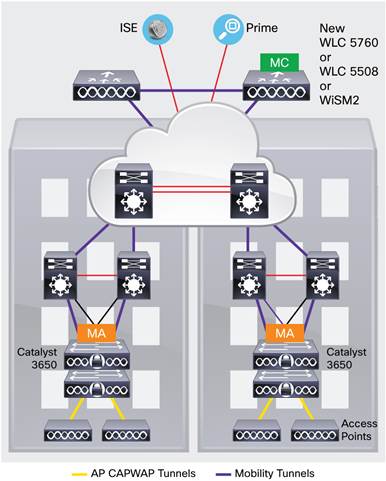
Branch
3650 is optimized for branch deployments when it operates in mobility controller mode. In this mode, not only can the switch terminate CAPWAP tunnels from the access points and provide client connectivity, it can also manage mobility within the branch. This eliminates the need for a local controller in every branch in addition to the access-layer switches. Also, complete visibility into the wired plus wireless traffic means that the WAN router can prioritize the right wired plus wireless traffic in and out of the branch. Figure 6 shows the Cisco Catalyst 3650 in a branch deployment.
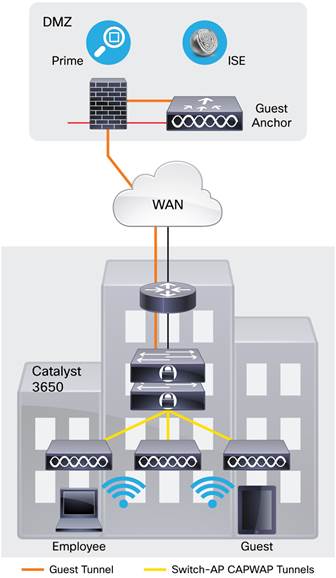
Deployment Options
Campus
In a campus-type deployment, operating the Cisco Catalyst 3650 in the mobility agent mode and centralizing the mobility controller functionality in a WLC 5760, WLC 5508, or WiSM2 helps achieve better scalability and performance. The Cisco Catalyst 3650 provides CAPWAP termination for access points, uniform policy enforcement for wireless clients, better wireless bandwidth, and uniform Cisco IOS Software-based configuration and monitoring for wired plus wireless features. The mobility controller provides central mobility, RRM, and CleanAir coordination.
Backward compatibility with traditional centralized wireless deployment mode on the WLC 5508, WiSM2, and WLC 5760 helps ensure that customers can migrate to the Cisco Catalyst 3650-based converged access approach in phases, providing a continued controller for existing access points. This migration also provides investment protection on the existing wireless controller infrastructure. A phased adoption of the new Cisco Catalyst 3650 helps ensure that migration to the converged access mode of wireless is seamless.

Branch
3650 is optimized for branch deployments when it operates in mobility controller mode. In this mode, not only can the switch terminate CAPWAP tunnels from the access points and provide client connectivity, it can also manage mobility within the branch. This eliminates the need for a local controller in every branch in addition to the access-layer switches. Also, complete visibility into the wired plus wireless traffic means that the WAN router can prioritize the right wired plus wireless traffic in and out of the branch. Figure 6 shows the Cisco Catalyst 3650 in a branch deployment.

Specifications
Cisco Catalyst 3650 Performance Specifications
|
Performance Numbers for All Switch Models |
|
|
Switching capacity |
176 Gbps on 48-port models (non-multigigabit models) 92 Gbps on 24-port models (non-multigigabit models) 254 Gbps on 24-port Multigigabit models with 2x10G uplink 272 Gbps on 24-port Multigigabit models with 4x10G uplink 392 Gbps on 48-port Multigigabit models with 4x10G uplink 472 Gbps on 48-port Multigigabit models with 8x10G uplink 472 Gbps on 48-port Multigigabit models with 2x40G uplink |
|
Stacking bandwidth |
160 Gbps |
|
Total number of MAC addresses |
32,000 |
|
Total number of IPv4 routes (ARP plus learned routes) |
24,000 |
|
FNF entries |
48,000 flow on 48-port models 24,000 flows on 24-port models |
|
DRAM |
4 GB |
|
Flash |
2 GB (non-Multigigabit models) and 4GB (Multigigabit models) |
|
VLAN IDs |
4,094 |
|
Total switched virtual interfaces (SVIs) |
1,000 |
|
Jumbo frame |
9198 bytes |
|
Total routed ports per 3650 stack |
208 |
|
Wireless |
|
|
Number of access points per switch/stack |
25 |
|
Number of wireless clients per switch/stack |
1000 |
|
Total number of WLANs per switch |
64 |
|
Wireless bandwidth per switch |
Up to 40 Gbps on 48-port models Up to 20 Gbps on 24-port models |
|
Supported Aironet access point series |
3700, 3600, 3500, 2600, 1600, 1260, 1140, 1040 |
|
Model |
Forwarding Rate |
|
4 x 1 Gigabit Ethernet Uplink-Models |
|
|
3650-24TS |
41.66 Mpps |
|
3650-24PS |
|
|
3650-48TS |
77.37 Mpps |
|
3650-48PS |
|
|
3650-48FS |
|
|
2 x 10 Gigabit Ethernet Uplink-Models |
|
|
3650-24TD 3650-24PD 3650-24PDM |
68.45 Mpps |
|
3650-48TD 3650-48PD |
104.16 Mpps |
|
3650-8X24PD |
172.61 Mpps |
|
3650-12X48FD |
261.90 Mpps |
|
4 x 10 Gigabit Ethernet Uplink-Models |
|
|
3650-48TQ 3650-48PQ 3650-48FQ 3650-48FQM |
130.95 Mpps |
|
3650-8X24UQ |
202.38 Mpps |
|
3650-12X48UQ |
291.66 Mpps |
|
8 x 10 Gigabit Ethernet Uplink-Models |
|
|
3650-12X48UR |
351.19 Mpps |
|
2 x 40 QSFP+ Uplink-Models |
|
|
3650-12X48UZ |
351.19 Mpps |
Dimensions, Weight, Acoustic, Mean Time between Failures, and Environmental Range Specifications for Cisco Catalyst 3650 Series Switches
|
Dimensions (H x W x D) |
Inches |
Centimeters |
|
WS-C3650-24T WS-C3650-24P WS-C3650-48T WS-C3650-48P |
1.73 x 17.5 x 17.625 |
4.4 x 44.5 x 44.8 |
|
WS-C3650-8X24PD |
||
|
WS-C3650-48F WS-C3650-8X24UQ WS-C3650-12X48UQ WS-C3650-12X48UR WS-C3650-12X48UZ |
1.73 x 17.5 x 19.125 |
4.4 x 44.5 x 48.6 |
|
WS-C3650-12X48FD |
||
|
WS-C3650-24PDM WS-C3650-48FQM |
1.73 x 17.5 x 11.625 |
4.4 x 44.5 x 29.6 |
|
Weight |
Pounds |
Kilograms |
|
WS-C3650-24T |
15.15 |
6.87 |
|
WS-C3650-24P |
16.00 |
7.26 |
|
WS-C3650-24PDM |
12.26 |
5.56 |
|
WS-C3650-8X24PD |
16.60 |
7.53 |
|
WS-C3650-8X24UQ |
16.71 |
7.58 |
|
WS-C3650-48T |
15.90 |
7.21 |
|
WS-C3650-48P |
16.75 |
7.60 |
|
WS-C3650-48F |
17.20 |
7.80 |
|
WS-C3650-12X48FD |
17.75 |
8.05 |
|
WS-C3650-12X48UQ |
17.75 |
8.05 |
|
WS-C3650-12X48UR |
17.80 |
8.08 |
|
WS-C3650-12X48UZ |
17.80 |
8.08 |
|
WS-C3650-48FQM |
12.65 |
5.74 |
|
STACK-T2-BLANK |
0.1 |
0.05 |
|
C3650-STACK-KIT |
0.25 |
0.11 |
|
MTBF Hours |
||
|
WS-C3650-24T |
661,800 |
|
|
WS-C3650-24P |
528,280 |
|
|
WS-C3650-8X24PD |
335,930 |
|
|
WS-C3650-8X24UQ |
233,780 |
|
|
WS-C3650-24PDM |
304,860 |
|
|
WS-C3650-48T |
527,580 |
|
|
WS-C3650-48P |
383,760 |
|
|
WS-C3650-48F |
383,760 |
|
|
WS-C3650-12X48FD |
227,490 |
|
|
WS-C3650-12X48UQ |
203,130 |
|
|
WS-C3650-12X48UR |
201,680 |
|
|
WS-C3650-12X48UZ |
203,190 |
|
|
WS-C3650-48FQM |
272,260 |
|
|
PWR-C2-250WAC |
751,642 |
|
|
PWR-C2-640WAC |
693,692 |
|
|
PWR-C2-1025WAC |
570,259 |
|
|
PWR-C2-640WDC |
706,759 |
|
|
PWR-C1-715WAC |
664,055 |
|
|
PWR-C1-1100WAC |
392,174 |
|
|
FAN-T1 |
16,661,470 |
|
|
Environmental Ranges |
||
|
With AC Power Supply Operating Environment and Altitude |
Normal operating temperature* and altitudes: -5ºC to +45ºC, up to 5000 feet (1500m) -5ºC to +40ºC, up to 10,000 feet (3000m) -5ºC to +35ºC, up to 13,000 feet (4000m) -5ºC to +30ºC, up to 16,400 feet (5000m) * Minimum ambient temperature for cold start is 32°F (0°C). |
|
|
Short-term* exceptional conditions: -5ºC to +50ºC, up to 5000 feet (1500m) -5ºC to +45ºC, up to 10,000 feet (3000m) -5ºC to +40ºC, up to 13,000 feet (4000m) -5ºC to +35ºC, up to 16,400 feet (5000m) -5ºC to +45ºC, at sea level with single fan failure * Not more than following in one-year period: 96 consecutive hours, or 360 hours total, or 15 occurrences. |
||
|
With AC Power Supply Operating Environment and Altitude for WS-C3650-24PDM and WS-C3650-48FQM |
Normal operating temperature* and altitudes: -5ºC to +45ºC, up to 5000 feet (1500m) -5ºC to +45ºC, up to 10,000 feet (3000m) * Minimum ambient temperature for cold start is 32°F (0°C). |
|
|
Short-term* exceptional conditions: -5ºC to +50ºC, up to 5000 feet (1500m) -5ºC to +50ºC, up to 10,000 feet (3000m) * Not more than following in one-year period: 96 consecutive hours, or 360 hours total, or 15 occurrences. |
||
|
With DC Power Supply Operating Environment and Altitude (NEBS) |
Normal operating temperature and altitudes: -5ºC to +45ºC, up to 6000 feet (1800m) -5ºC to +40ºC, up to 10,000 feet (3000m) -5ºC to +35ºC, up to 13,000 feet (4000m) -5ºC to +30ºC, up to 16,400 feet (5000m) |
|
|
Short-term* exceptional conditions: -5ºC to +55ºC, up to 6000 feet (1800m) -5ºC to +50ºC, up to 10,000 feet (3000m) -5ºC to +45ºC, up to 13,000 feet (4000m) -5ºC to +40ºC, up to 16,400 feet (5000m) -5ºC to +45ºC, at sea level with single fan failure * Not more than following in one-year period: 96 consecutive hours, or 360 hours total, or 15 occurrences. |
||
|
Relative Humidity |
5% to 96%, noncondensing |
|
|
Acoustic Noise Measured Per ISO 7779 and Declared Per ISO 9296 Bystander Positions Operating to an Ambient Temperature of 25°C |
With AC or DC power supply (with 16 PoE+ ports loaded): LpA: 45dB typical, 48dB maximum 42dB typical, 45dB maximum for WS-C3650-24PDM and WS-C3650-48FQM LwA: 5.5B typical, 5.8B maximum 5.3B typical, 5.6B maximum for WS-C3650-24PDM and WS-C3650-48FQM Typical: Noise emission for a typical configuration Maximum: Statistical maximum to account for variation in production |
|
|
Storage Environment |
Temperature: -40 to 158º F (-40 to 70º C) Altitude: 16,400 ft (5,000 m) |
|
|
Vibration |
Operating: 0.41Grms from 3 to 500Hz with spectral break points of 0.0005 G2/Hz at 10Hz and 200Hz 5dB/octave roll off at each end. |
|
|
Nonoperating: 1.12Grms from 3 to 500Hz with spectral break points of 0.0065 G2/Hz at 10Hz and 100Hz 5dB/octave roll off at each end. |
||
|
Shock |
Operating: 30G, 2ms half sine |
|
|
Nonoperating: 55G, 10ms trapezoid |
||
Connectors for Cisco Catalyst 3650 Series
|
Connectors and cabling |
|
|
Power connectors |
|
Management and Standards Support for the Cisco Catalyst 3650 Series
|
Description |
Specification |
|
|
Management |
BRIDGE-MIB CISCO-AUTH-FRAMEWORK-MIB CISCO-BGP4-MIB, BGP4-MIB CISCO-BRIDGE-EXT-MIB CISCO-BULK-FILE-MIB CISCO-CABLE-DIAG-MIB CISCO-CALLHOME-MIB CISCO-CEF-MIB CISCO-CIRCUIT-INTERFACE-MIB CISCO-ENTITY-VENDORTYPE-OID-MIB CISCO-CONTEXT-MAPPING-MIB CISCO-DEVICE-LOCATION-MIB CISCO-DHCP-SNOOPING-MIB CISCO-EIGRP-MIB CISCO-EMBEDDED-EVENT-MGR-MIB CISCO-ENTITY-FRU-CONTROL-MIB CISCO-ENTITY-SENSOR-MIB ENTITY-MIB CISCO-ERR-DISABLE-MIB CISCO-CONFIG-COPY-MIB CISCO-FLOW-MONITOR-MIB CISCO-FTP-CLIENT-MIB CISCO-HSRP-EXT-MIB CISCO-HSRP-MIB CISCO-IETF-ISIS-MIB CISCO-IF-EXTENSION-MIB CISCO-IGMP-FILTER-MIB CISCO-CONFIG-MAN-MIB CISCO-IP-CBR-METRICS-MIB CISCO-IPMROUTE-MIB CISCO-IP-STAT-MIB CISCO-IP-URPF-MIB CISCO-L2L3-INTERFACE-CONFIG-MIB CISCO-LAG-MIB CISCO-LICENSE-MGMT-MIB CISCO-MAC-AUTH-BYPASS-MIB CISCO-MAC-NOTIFICATION-MIB CISCO-MDI-METRICS-MIB CISCO-FLASH-MIB CISCO-OSPF-MIB CISCO-OSPF-TRAP-MIB CISCO-PAE-MIB CISCO-PAGP-MIB CISCO-PIM-MIB CISCO-PING-MIB CISCO-PORT-QOS-MIB CISCO-PORT-SECURITY-MIB CISCO-PORT-STORM-CONTROL-MIB CISCO-POWER-ETHERNET-EXT-MIB CISCO-PRIVATE-VLAN-MIB CISCO-PROCESS-MIB CISCO-PRODUCTS-MIB CISCO-RF-MIB CISCO-RTP-METRICS-MIB CISCO-RTTMON-MIB CISCO-SMART-INSTALL-MIB |
CISCO-SNMP-TARGET-EXT-MIB CISCO-STACKMAKER-MIB CISCO-MEMORY-POOL-MIB CISCO-STP-EXTENSIONS-MIB CISCO-SYSLOG-MIB CISCO-TCP-MIB CISCO-UDLDP-MIB CISCO-VLAN-IFTABLE-RELATIONSHIP-MIB CISCO-VLAN-MEMBERSHIP-MIB CISCO-VTP-MIB EtherLike-MIB HC-RMON-MIB IEEE8021-PAE-MIB IEEE8023-LAG-MIB IF-MIB IGMP-MIB IGMP-STD-MIB IP-FORWARD-MIB IP-MIB IPMROUTE-STD-MIB LLDP-EXT-MED-MIB LLDP-MIB NOTIFICATION-LOG-MIB OLD-CISCO-MEMORY-MIB CISCO-CDP-MIB POWER-ETHERNET-MIB RMON2-MIB RMON-MIB SNMP-COMMUNITY-MIB SNMP-FRAMEWORK-MIB SNMP-MPD-MIB SNMP-NOTIFICATION-MIB SNMP-PROXY-MIB SNMP-TARGET-MIB SNMP-USM-MIB SNMPv2-MIB SNMP-VIEW-BASED-ACM-MIB TCP-MIB UDP-MIB CISCO-IMAGE-MIB CISCO-STACKWISE-MIB AIRESPMACE-WIRELESS-MIB CISCO-LWAPP-IDS-MIB CISCO-LWAPP-AP-MIB CISCO-LWAPP-CCX-RM-MIB CISCO-LWAPP-CLIENT-ROAMING-MIB CISCO-LWAPP-DOT11-CCX-CLIENT-DIAG-MIB CISCO-LWAPP-DOT11-CCX-CLIENT-MIB CISCO-LWAPP-DOT11-CLIENT-CCX-REPORTS-MIB CISCO-LWAPP-DOT11-CLIENT-MIB CISCO-LWAPP-DOT11-MIB CISCO-LWAPP-DOWNLOAD-MIB CISCO-LWAPP-LINKTEST-MIB CISCO-LWAPP-MFP-MIB CISCO-LWAPP-MOBILITY-EXT-MIB CISCO-LWAPP-QOS-MIB CISCO-LWAPP-REAP-MIB CISCO-LWAPP-ROGUE-MIB CISCO-LWAPP-RRM-MIB CISCO-LWAPP-SI-MIB CISCO-LWAPP-TSM-MIB CISCO-LWAPP-WLAN-MIB CISCO-LWAPP-WLAN-SECURITY-MIB |
|
Standards |
IEEE 802.1as IEEE 802.1s IEEE 802.1w IEEE 802.11 IEEE 802.1x IEEE 802.1x-Rev IEEE 802.3ad IEEE 802.3af IEEE 802.3at IEEE 802.3bz IEEE 802.3x full duplex on 10BASE-T, 100BASE-TX, and 1000BASE-T ports IEEE 802.1D Spanning Tree Protocol IEEE 802.1p CoS prioritization IEEE 802.1Qat Stream Reservation Protocol IEEE 802.1Qav IEEE 802.1Q VLAN IEEE 802.3 10BASE-T specification IEEE 802.3u 100BASE-TX specification IEEE 802.3ab 1000BASE-T specification IEEE 802.3z 1000BASE-X specification |
|
Power Specifications for Cisco Catalyst 3650 Series
|
Description |
Specification |
|
|||
|
|
PWR-C2-1025 WAC |
PWR-C2-640 WAC |
PWR-C2-250 WAC |
PWR-C2-640 WDC |
WS-C3650-24PDM/WS-C3650-48FQM Switches |
|
Power Supply Rated Maximum |
1025W |
640W |
250W |
640W |
975W |
|
Total Output BTU (Note: 1000 BTU per hr = 293 W) |
3497 BTU/hr, 1025W |
2183 BTU/hr, 640W |
853 BTU/hr, 250W |
2188 BTU/hr, 640W |
3326.8 BTU/hr, 975W |
|
Input-Voltage Range and Frequency (Note: ±10% of "Input-Voltage Range”) |
115-240VAC, 50-60 Hz |
100-240VAC, 50-60 Hz |
100-240VAC, 50-60 Hz |
-36VDC to -72VDC |
100-240VAC, 50-60 Hz |
|
Input Current |
12-6A |
8-4A |
4-2A |
21 - 10.5 A |
12-5A |
|
Output Ratings |
12V @ 20.83A -54V @ 14.6A |
12V @ 20.83A -54V @ 7.36A |
12V @ 20.83A |
12V @ 20.83A -54V @ 7.36A |
12V @ 16.66A -54V @ 14.3A |
|
Output Holdup Time |
10 ms minimum @ 102.5VAC |
16.7 ms minimum @ 100VAC |
16.7 ms minimum @ 100VAC |
> 2ms@-48VDC |
20 ms minimum @ 100VAC |
|
Power-Supply Input Receptacles |
IEC 320-C16 (IEC60320-C16) |
IEC 320-C16 (IEC60320-C16) |
IEC 320-C13 (IEC60320-C13) |
Terminal strip |
IEC 320-C16 (IEC60320-C16) |
|
Power Cord Rating |
13A |
13A |
10A |
20A @ 100VDC |
15A |
|
Physical Specifications |
(H x W x D): 1.58 X 3.75 X 13.25 in (4.0 x 9.5 x 33.7 cm) Weight: 3.55 lb (1.61 kg) |
(H x W x D): 1.58 X 3.75 X 11.75 in (4.0 x 9.5 x 29.8 cm) Weight: 3.1 lb (1.41 kg) |
(H x W x D): 1.58 X 3.75 X 11.75 in (4.0 x 9.5 x 29.8 cm) Weight: 2.55 lb (1.16 kg) |
(H x W x D): 1.58 X 3.75 X 11.75 in (4.0 x 9.5 x 29.8 cm) Weight: 2.75 lb (1.25 kg) |
N/A |
|
Operating Temperature |
For the operating temperature ranges at various altitudes of AC and DC power supply module powered switches, see Table 1. |
||||
|
Storage Temperature |
-40 to 158°F (-40 to 70°C) |
||||
|
Relative Humidity Operating and Nonoperating Noncondensing |
5 to 96% noncondensing |
5 to 95% noncondensing |
|||
|
Altitude |
16,400 ft. (5,000 meters) |
10,000 ft. (3,000 meters) |
|||
|
MTBF |
Calculated MTBF must be greater than 300,000 using Telcordia SR-332, Method 1, Issue 3. Demonstrated MTBF is 500,000 hr (with 90% confidence level). |
||||
|
EMI and EMC Compliance |
“AC OK”: Input power to the power supply is OK “PS OK”: Output power from the power supply is OK |
||||
|
Safety Compliance |
For the operating temperature ranges at various altitudes of AC and DC power supply module powered switches, see Table 1. |
||||
|
LED Indicators |
-40 to 158°F (-40 to 70°C) |
N/A |
|||
|
Description |
Specification |
|
|
|
PWR-C1-1100WAC |
PWR-C1-715WAC |
|
Power supply rated maximum |
1100W |
715W |
|
Total output BTU (Note: 1000 BTU/hr = 293W) |
3793 BTU/hr, 1100W |
2465 BTU/hr, 715W |
|
Input-voltage range and frequency |
115-240VAC, 50-60 Hz |
100-240VAC, 50-60 Hz |
|
Input current |
12-6A |
10-5A |
|
Output ratings |
-56V at 19.64A |
-56V at 12.8A |
|
Output holdup time |
10 ms minimum at 102.5VAC |
16.7 ms minimum at 100VAC |
|
Power-supply input receptacles |
IEC 320-C16 (IEC60320-C16) |
IEC 320-C16 (IEC60320-C16) |
|
Power cord rating |
13A |
13A |
|
Physical specifications |
(H x W x D): 1.58 X 3.25 X 13.7 in Weight: 3 lb (1.4 kg) |
(H x W x D): 1.58 X 3.25 X 12.20 in Weight: 2.8 lb (1.3 kg) |
|
Operating temperature |
23 to 113°F (-5 to 45°C) |
|
|
Storage temperature |
-40 to 158°F (-40 to 70°C) |
|
|
Relative humidity operating and nonoperating noncondensing |
5 to 90% noncondensing |
|
|
Altitude |
10,000 ft. (3000 meters), up to 45°C |
|
|
MTBF |
Calculated MTBF must be greater than 300,000 using Telcordia SR-332, Method 1, Case 3. Demonstrated MTBF is 500,000 hr (with 90% confidence level). |
|
|
EMI and EMC compliance |
FCC Part 15 (CFR 47) Class A EN 55022 Class A CISPR 22 Class A AS/NZS 3548 Class A BSMI Class A (AC input models only) VCCI Class A EN 55024, EN300386, EN 50082-1, EN 61000-3-2, EN 61000-3-3 EN61000-4-2, EN61000-4-3, EN61000-4-4, EN61000-4-5, EN61000-4-6, EN 61000-6-1 |
|
|
Safety compliance |
UL 60950-1, CAN/CSA-C22.2 No. 60950-1, EN 60950-1, IEC 60950-1, CCC, CE Marking |
|
|
LED indicators |
“AC OK”: Input power to the power supply is OK “PS OK”: Output power from the power supply is OK |
|
Power Consumption of Standalone Cisco Catalyst 3650 Series Switches
|
Model |
Fixed Uplink |
Power Consumption (Watts) (No More Than) |
|||
|
0% Traffic |
10% Traffic |
100% Traffic |
Weighted Average |
||
|
WS-C3650-24TS |
4 x Gigabit Ethernet with Small Form-Factor Pluggable (SFP) |
43.9 |
56.4 |
57.1 |
55.21 |
|
WS-C3650-48TS |
61.1 |
85.1 |
86.4 |
82.85 |
|
|
WS-C3650-24PS |
53.8 |
65.3 |
65.9 |
64.18 |
|
|
WS-C3650-48PS |
81.4 |
98.7 |
99.5 |
97.09 |
|
|
WS-C3650-48FS |
90.8 |
108.7 |
109.4 |
106.98 |
|
|
WS-C3650-24TD |
2 x 10 Gigabit Ethernet with SFP+ and 2 x 10 Gigabit Ethernet with SFP+ or 4 x Gigabit Ethernet with SFP |
54.0 |
60.8 |
63.0 |
60.35 |
|
WS-C3650-48TD |
73.3 |
90.9 |
93.9 |
89.40 |
|
|
WS-C3650-24PD |
61.1 |
68.3 |
70.1 |
67.75 |
|
|
WS-C3650-24PDM |
63.8 |
72.3 |
76.2 |
71.9 |
|
|
WS-C3650-48PD |
80.3 |
99.1 |
101.5 |
97.45 |
|
|
WS-C3650-48FD |
88.8 |
106.5 |
109.4 |
105.03 |
|
|
WS-C3650-8X24PD |
103 |
107.8 |
111.5 |
107.7 |
|
|
WS-C3650-12X48FD |
158.7 |
168.6 |
172.7 |
168 |
|
|
WS-C3650-48TQ |
4 x 10 Gigabit Ethernet with SFP+ or 4 x Gigabit Ethernet with SFP |
73.0 |
91.9 |
96.7 |
90.47 |
|
WS-C3650-48PQ |
86.4 |
103.4 |
107.4 |
102.10 |
|
|
WS-C3650-48FQ |
96.6 |
116.2 |
120.5 |
114.69 |
|
|
WS-C3650-48FQM |
74.1 |
89.2 |
95.8 |
88.4 |
|
|
WS-C3650-8X24UQ |
110.0 |
115.3 |
123.3 |
115.6 |
|
|
WS-C3650-12X48UQ |
170.4 |
179.9 |
186.6 |
179.7 |
|
|
WS-C3650-12X48UR |
8 x 10 Gigabit Ethernet with SFP+ or 8 x Gigabit Ethernet with SFP |
174.5 |
184.9 |
195.7 |
184.9 |
|
WS-C3650-12X48UZ |
2 x 40 Gigabit Ethernet with Quad Small Form-Factor Pluggable+ (QSFP+) |
162.4 |
173.7 |
184.0 |
173.6 |
Safety and Compliance
|
Description |
Specification |
|
Safety Certifications |
UL 60950-1 Second Edition CAN/CSA-C22.2 No. 60950-1 Second Edition EN 60950-1 Second Edition IEC 60950-1 Second Edition GOST NOM (obtained by partners and distributors) |
|
Electromagnetic Emissions Certifications |
47CFR Part 15 (CFR 47) Class A (FCC Part 15 Class A) AS/NZS CISPR22 Class A CISPR22 Class A EN55022 Class A ICES003 Class A VCCI Class A EN61000-3-2 EN61000-3-3 KN22 Class A KCC CNS13438 Class A EN55024 CISPR24 KN24 |
|
Environmental |
Reduction of Hazardous Substances (ROHS) 5 |
|
Noise Specifications |
Office Product Spec: 48dBA at 25°C (refer to ISO 7779) |
|
Telco |
Common Language Equipment Identifier (CLEI) Code |
12 tháng
Sản phẩm xem thêm
Thiết bị chuyển mạch Cisco Catalyst 3650-12X48UR-L Switch
Cisco Catalyst 3650 48 Port mGig (12 mGig+36 Gig), 8x10G Uplink, LAN Base
Thiết bị chuyển mạch Cisco Catalyst 3650-48FQM-S Switch
Cisco Catalyst 3650 48 Port Mini , 4x10G Uplink, IP Base
Thiết bị chuyển mạch Cisco Catalyst 3650-48FS-E Switch
Cisco Catalyst 3650 48 Port Full PoE 4x1G Uplink IP Services
Thiết bị chuyển mạch Cisco Catalyst 3650-8X24UQ-S Switch
Cisco Catalyst 3650 24 Port mGig (8 mGig+16 Gig), 4x10G Uplink, IP Base
Chủ sở hữu Website thietbicisco.vn thuộc về:
CÔNG TY TRÁCH NHIỆM HỮU HẠN THƯƠNG MẠI DỊCH VỤ KẾT NỐI MẠNG
Tên quốc tế: KET NOI MANG SERVICE TRADING COMPANY LIMITED
Tên viết tắt: KET NOI MANG SERVICE TRADING CO.,LTD
Số chứng nhận ĐKKD: 0314815571
Ngày cấp: 03/01/2018, nơi cấp: Sở KH & ĐT TPHCM
Người đại diện: VĂN NHẬT TÂN
Địa chỉ: Số 36/34 Đường Nguyễn Gia Trí, Phường Thạnh Mỹ Tây, Thành phố Hồ Chí Minh, Việt Nam
Địa chỉ giao dịch: 1061 Phạm Văn Đồng, Phường Linh Xuân, Thành phố Hồ Chí Minh, Việt Nam
Điện thoại: 84.028.35125568
Hotline: 09 014 014 86
Website: ketnoimang.vn | thietbifortinet.vn | thietbicisco.vn | knmrack.vn | alocafe.vn
Email: sales@ketnoimang.vn

































